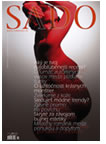 |
|||

About the usefulness of the beautiful Monsters
by Étienne Cornevin
Among the reasons for the success of fundamentalist ideologies fascist, communist, or from now on also islamist we should perhaps include the absence of a wide-reaching influential press for women.
Women, busy mainly with being beautiful, fashionable, sexy, and finding a husband or a job allowing them to fulfil their wishes, do not have much amatory energy left for austere causes defended by boring men who, on top of it all, are loath to grant women the freedom and the importance they claim. Seen from a historical and anti-totalitarian point of view, the ongoing boom of this feminine press launched fifty years ago in France and some 15 years ago in Slovakia is certainly a very good thing. And, if the observer is a man endowed with an a priori (of course totally irrational) liking for women, then he will get weekly renewable reasons to be happy about it. From the point of view of a woman who knows that she is looked at and judged according to the models celebrated in "her" magazines, the existence and power of that sort of press may prove much less exciting. For if by chance Nature, easily distracted, had forgotten to give her the appearance of a "top model", and if the too assiduous company of this type of "literature" had insinuated in her a conviction not devoid of a semblance of logic, according to which not to be "top" is to be nothing (though "bottom" is not nothing, and there are uncountable floors between the top and the basement), then this woman is well advanced in one of those pathetic little "cinegenic" scenarios which, taking her through the classic stages of anorexia, fashion-victimization, loneliness, depression and drug-addiction, will lead her to the graveyard quicker than should be. Just like the Christian religion which, however, she opposed in so many respects, the neo-pagan religion of the body, physical beauty, luxury and celebrity, has an underside of oppression, destruction and terror.
What to do? It is difficult to see what the she-Messiah who would deliver women (and quite a few men) from the obsession of beauty as defined in the women's press, would look like: (if that Messiah were beautiful, those who think themselves ugly would not believe in her; if she were ugly, those who think of themselves that they are beautiful and therefore have no need to be delivered from what fashion dictates would oppose her.) Thus, hope for a radical solution has not much of a basis.
A quite subtle way, which would ask for quite a sharp sense of humorous "confusionism", would be to show in a sensitive, immediately convincing manner that beauty is equally without ceasing to be beautiful monstrous. To show how extremely astonishing this body is, which women of our days, stakhanovites of beauty, are constantly asked to keep fit, constantly to look after, improve and highlight in ways constantly innovated. To make clear, through simple processes, the most familiar as well as the strangest, the ideal as well as the perfectly ugly and grotesque; and therefore rather queer.
An example?
if the heads of beautiful young women looking at the sky with an expression of pleasure are represented in close view from underneath the perspective of adoration and if they are properly enlarged, those heads take the aspect of a fantastic landscape, all the stranger as their hair disappears and their ears, noses, lips and chins stand out in a very marked relief (one will have certainly noticed that there is not not yet? any top model among the landscapes; well... if there were fashion magazines of landscapes, then Kilimanjaro would surely be more often on the first page than Strbske Pleso.)
bodies which, when taken individually, are rather attractive, but if piled up together, become as erotic as a flock of sheep packed together to protect themselves from... who knows what (attacks by ostriches?)
feet and hands put on top of one another duly form hideous hybrids (but, as we see very well that they are not true, we conclude that they are there just "as a joke", and then, if we have a logical mind, we laugh.)
triturated and kneaded breasts take on a grotesque aspect which corresponds very little to the firm and bulging picture given by the magazines and give a good visual equivalent of those words which are vulgar as ordinarily used, apart from the women's press (with words such as tits, knockers, melons, yabos, nipples or titties, to mention only some, the anti-poetic resources of French are enormous, and I admit I never bothered about finding out if the Slovak language could compete on this point with the language of Rabelais, but I have no doubt that we can observe the same exclusion of this type of belittling vocabulary, whether verbal or visual, in the Slovak magazines for women.) Nor that it has the same liberating function.
In a theorem: ugliness wanted, forced delivers us from the obsession of beauty. The Joke body-monsters, there as a joke, save us from normality: our capacity to make monsters out of ourselves makes us forget the pointlessness of our efforts to reach beauty. Women probably understand more easily what Dorota Sadovska's depictions are about, but for an ordinary man, closer to Chinese than to the universe of the women's press (especially if he is Chinese), it might be useful to have had daughters and to have observed that they give an enormous importance to their figure, as well as to the good development of all the attributes which are supposed to make them attractive, and at the same time they are capable of speaking in an extraordinarily despising way of their bodies (if such an item is not at hand, we could always try to borrow a daughter from a neighbour, but in that case, it would be better to postpone the reading of Nabokov's works).
The philosopher Schopenhauer, who was not gay but just a misanthropist and a misogynist, disputed energetically the fact that the monopoly of beauty should traditionally be given to women : in his eyes, the male gender did not have less rights to the epithet "beautiful". Here was someone who was not in danger of being a victim of the feminist religion! (which already existed, though in a lesser measure, during the first half of the 19th century; let us note that he the surly philosopher is a contemporary of Sacher-Masoch, who defined in his "Venus with fur" an illness of love, idealizing, which is far more widespread among women, in a narcissistic form, than among men)...
Dorota Sadovska perhaps wants to say to the users of the women's press that they had better read Schopenhauer. Yes, that is probably it. Optimistic advice, for sure, but not bad.
ιtienne cornevin
graduated professor of zen hysteria
(from French translated by Susanne Hof)